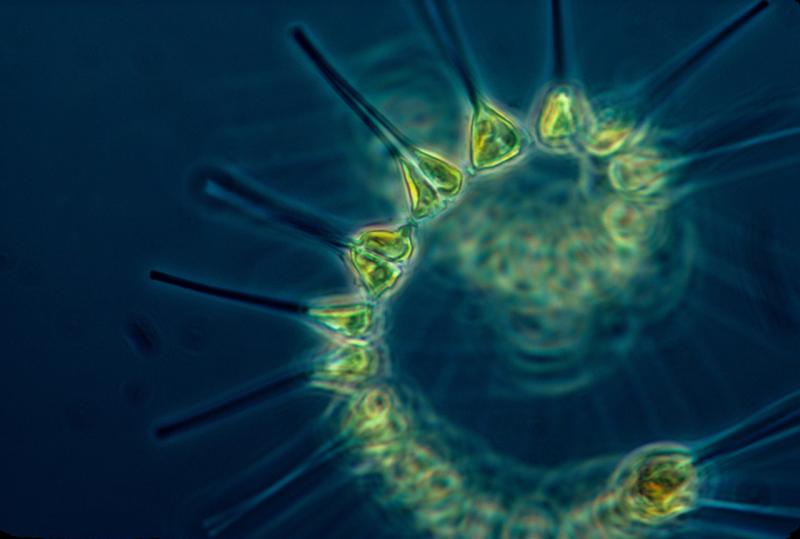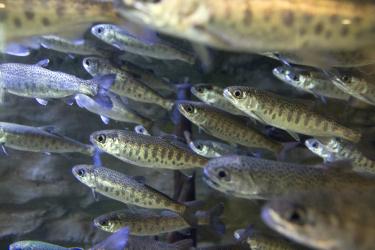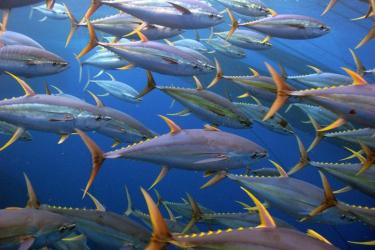Our Ecosystem Monitoring cruises help researchers understand and predict changes in the Northeast shelf ecosystem and its fisheries. EcoMon cruises collect data used to monitor the distribution and abundance of zooplankton and larval fish, water temperature and salinity, and ocean acidification. Researchers also collect observations of seabirds, marine mammals, and sea turtles.
The survey lost 8 of the planned 18 days of cruise time to crew shortages on the planned departure date, and about half a day to poor weather. Between November 1 and Nov 10, we visited 83 stations, 52 percent of the coverage originally planned. To make the most of the time available we altered our cruise track and prioritized collection of depth-discrete water samples for ocean acidification monitoring.
Most of the lost coverage occurred south of the Hudson River Valley, between Hudson Canyon and Cape Hatteras, North Carolina. Calm seas for the first week of the cruise allowed the science team and ship’s crew aboard NOAA Ship Pisces to sample portions of southern New England, Georges Bank, and eastern Gulf of Maine waters. A strong storm system at the end of the cruise affected station coverage and deployments in the western Gulf of Maine.
The plankton—tiny animals and young stages of some larger ones—we gather provide information about the food chain supporting fisheries and marine mammals. Scientists use our larval fish and egg samples to learn more about fish stock spawning and help estimate stock abundance. By measuring physical and chemical conditions like temperature and salinity, we can describe ecosystem productivity, spawning, larval recruitment, fish condition, and species distributions.
Core Sampling Summary
Plankton Collection
During this survey, we conducted “bongo” net tows at 67 stations. We attach fine-mesh nets to adjoined steel rings, causing them to resemble bongo drums when deployed. Bongo net tows collect zooplankton, larval fish, and fish eggs. Researchers will use samples from this survey to update indices of plankton abundance used in the environmental assessments.
At the beginning and end of the survey, we conducted supplemental plankton sampling within five offshore wind lease areas:
- Liberty Wind
- Vineyard Wind
- Mayflower Wind
- South Fork
- Bay State
Conductivity, Temperature, and Depth Profiles
The crew deployed an instrument that can measure conductivity, temperature, and depth at all 83 stations on this survey. Seawater conducts electricity. This “conductivity” varies with the amount of dissolved salts in the ocean, and scientists use it to estimate the salinity of seawater. The combination of temperature and salinity at various depths helps define marine habitat boundaries, track ocean circulation, and monitor changes in climate. This can help explain changes in marine species distribution and productivity.
Ocean Acidification Monitoring
To monitor marine carbon cycling and ocean acidification, scientists collected water samples and measured dissolved inorganic carbon, total alkalinity, pH, and nutrients at 16 stations. Increases in dissolved carbon dioxide can increase acidity of the water, which can in turn affect shellfish and other sensitive organisms. The NOAA Ocean Acidification Program funded this work. It was conducted in partnership with NOAA’s Atlantic Oceanographic and Meteorological Laboratory in Miami.
The crew also collected pteropods from the water column. Researchers examine the condition of the pteropod shells to measure the biological effects of ocean acidification. We conduct pteropod measurements in partnership with the Bermuda Institute of Ocean Science, where the measurement technique was developed by Dr. Amy Maas.
Special Collection Summary
Our EcoMon program collaborates with other agencies and institutions, supporting research that enhances core EcoMon sampling.
Visual Sighting
Two observers were aboard to watch for and record data on seabirds, marine mammals, and sea turtles we encountered along the cruise track. This is part of the Atlantic Marine Assessment Program for Protected Species. The program is a partnership among scientists from NOAA, the U.S. Fish and Wildlife Service, the Bureau of Ocean Energy Management, and the U.S. Navy.
Phytoplankton Monitoring
We deployed an imaging flow cytobot to image and count phytoplankton cells from surface waters throughout the ship’s transit. This work is part of a National Science Foundation project led by Woods Hole Oceanographic Institution. Collaborators include the University of Massachusetts Dartmouth, the University of Rhode Island, Wellesley College, and NOAA Fisheries. Technical difficulties during the cruise limited the spatial coverage of the cytobot.
Community Production
We collected samples from the plankton nets for stable isotope analysis being conducted by a University of Rhode Island researcher. The project examines the spatial distribution of plankton carbon and nitrogen isotopes in the offshore samples. It then compares the results to those obtained from samples taken from Narragansett Bay and Block Island Sound.
Ocean Forecasting
We deployed four drifters for the NOAA Global Drifter Program. The program uses satellite-tracked surface drifting buoys to meet the scientific community needs for an accurate and globally dense set of in-situ observations of:
- Mixed layer currents
- Sea surface temperature
- Atmospheric pressure
- Winds and salinity



